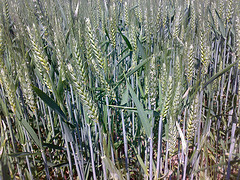There is an abundance of species of wheat available across the world. Even these wheat species will vary between botanical classification systems, as will their descriptions. Some of the most cultivated species of wheat include common wheat (the most widely cultivated in the world), durum (second most widely cultivated), einkorn (has both wild and cultivated variants), emmer (cultivated in ancient times but not as much today) and spelt (cultivated in limited quantities). There are also a number of classes that are used in the United States that include durum (a grain used to make semolina flour), hard red spring (used for bread), hard red winter (can be used in bread and with flour for pie crusts), soft red winter (low-protein and used for cakes, biscuits and muffins), hard white (used for bread and brewing) and soft white (low protein and used to make pastry flour).
Wheat is typically classified by considering a number of factors and characteristics. The growing season divides wheat into winter wheat and spring wheat while the gluten content determines whether a wheat species is hard (high protein) or soft (high starch). Grain colour, red, white or amber, can also add the classification of wheat, as can the protein content. The colour of wheat is determined by the phenolic compounds and browning enzymes found within the grains. Red wheat often needs bleaching so naturally white wheat is often more expensive to buy on the market. The protein in wheat can vary from between ten and fifteen per cent, the lowest percentages are found in soft wheat and the higher in hard wheat. Wheat can be classified in terms of their protein gluten. This determines how suitable they are for a particular dish. For example, the protein gluten in durum wheat is not elastic but is strong and is therefore good for making pasta.
Wheat is typically classified by considering a number of factors and characteristics. The growing season divides wheat into winter wheat and spring wheat while the gluten content determines whether a wheat species is hard (high protein) or soft (high starch). Grain colour, red, white or amber, can also add the classification of wheat, as can the protein content. The colour of wheat is determined by the phenolic compounds and browning enzymes found within the grains. Red wheat often needs bleaching so naturally white wheat is often more expensive to buy on the market. The protein in wheat can vary from between ten and fifteen per cent, the lowest percentages are found in soft wheat and the higher in hard wheat. Wheat can be classified in terms of their protein gluten. This determines how suitable they are for a particular dish. For example, the protein gluten in durum wheat is not elastic but is strong and is therefore good for making pasta.

